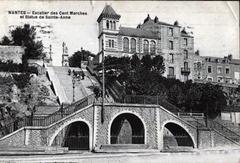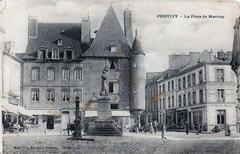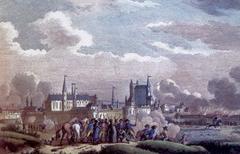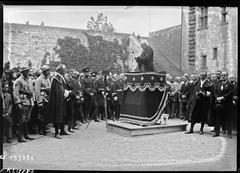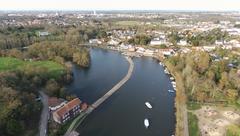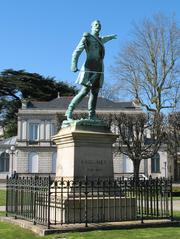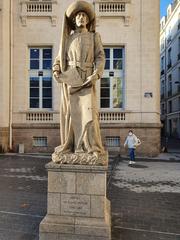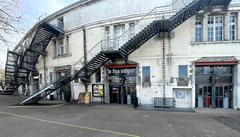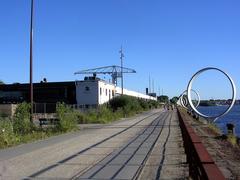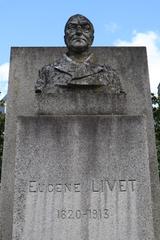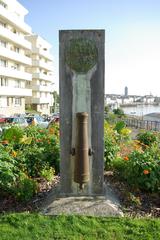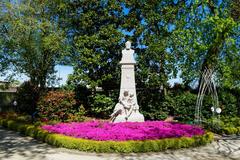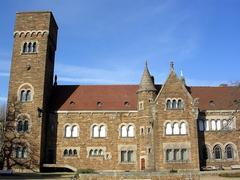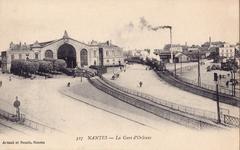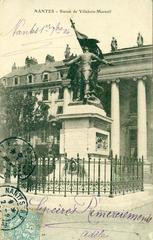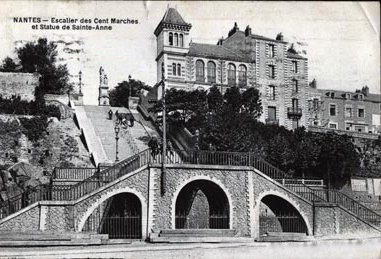
Sainte Anne Nantes Visiting Hours, Tickets, and Historical Site Guide
Date: 14/06/2025
Introduction: Sainte Anne, Nantes—A Hilltop District of Heritage and Culture
Nestled atop a scenic hill overlooking the Loire River, Sainte Anne in Nantes, France, is a district where the city’s ancient roots meet modern vibrancy. With a history stretching back to Gallic settlements around 70 BC, Sainte Anne has evolved from a prehistoric community and Roman outpost into a vital industrial center, later transforming into a lively, culturally rich neighborhood. Today, the area is celebrated for its architectural landmarks, panoramic viewpoints, innovative use of industrial heritage, and strong spirit of community (French Moments; Wikipedia; Patrimonia Nantes; Sainte Anne Saint Clair Parish).
This guide provides a comprehensive overview of Sainte Anne’s historical significance, visiting hours, ticket information, accessibility, and practical tips—helping you plan an enriching exploration of one of Nantes’ most distinctive districts.
Sainte Anne’s Historical Context
Ancient Beginnings and Urban Evolution
Sainte Anne’s origins are deeply intertwined with the city of Nantes. Archaeological finds confirm prehistoric habitation, while the Gallic tribe of the Namnetes established an early settlement at the rivers’ confluence around 70 BC (French Moments). The area flourished under Roman rule, later becoming part of the fortified medieval city—signified by the construction of the Château des Ducs de Bretagne and other key landmarks (PlanetWare).
Originally an island (Île Sainte-Anne), the district was integrated into Nantes’ urban fabric in the early 20th century following land reclamation and urban development (Wikipedia). Streets and quays named after French colonies reflect its maritime connections and economic growth during Nantes’ era as a major Atlantic port.
Industrial Heritage and Maritime Significance
The 20th century brought rapid industrialization to Sainte Anne. The area became a shipbuilding powerhouse, home to the renowned Dubigeon shipyards and other factories. These industries shaped the local economy and architecture, leaving behind iconic cranes, warehouses, and brick houses. As industrial activity declined in the 1960s and 1980s, the district began to reinvent itself—transforming former shipyards and factories into cultural venues, restaurants, and creative spaces (Patrimonia Nantes).
Nantes’ prosperity during the Triangular Trade era (17th–19th centuries) is still visible in Sainte Anne’s colonial street names and maritime infrastructure (French Moments; Wikipedia). The decline of the port and shipyards led to an urban renewal that now characterizes much of the district’s lively, creative atmosphere.
Architectural and Cultural Landmarks
Église Sainte-Anne
A defining feature of the district, the Église Sainte-Anne de Nantes sits atop the butte, offering panoramic city views and serving as a spiritual and community hub. Built in the mid-19th century, its interior features significant religious artworks, and the climb to its bell tower (122 steps) rewards visitors with sweeping vistas.
- Visiting Hours: Typically open 9:00 AM–6:00 PM; hours may vary during services or special events. (Sainte Anne Saint Clair Parish)
- Tickets: Free entry; donations encouraged.
- Guided Tours: Available by request via the Nantes tourism office.
Butte Sainte-Anne and Promenade des Belvédères
Known as Nantes’ “Petit Montmartre,” the Butte Sainte-Anne is a hilltop area with winding streets, brick houses, and gardens. The Promenade des Belvédères offers some of the city’s best viewpoints, especially at sunrise and sunset (Le Voyage à Nantes).
Jardin Extraordinaire
This lush terraced garden, built into the former Misery quarry, features tropical and Mediterranean plants, waterfalls, and children’s play areas. It’s a prime example of Nantes’ creative reuse of industrial spaces.
- Opening Hours: Daily, 10:00 AM–7:00 PM (extended in summer).
- Tickets: Free entry.
Musée Jules Verne
Located in a 19th-century mansion atop the butte, the Musée Jules Verne celebrates the life and works of the famous author. Exhibits include manuscripts, artifacts, and interactive displays.
- Hours: Tuesday–Sunday, 10:00 AM–6:00 PM.
- Tickets: Adults €6, reduced €4, free for children under 12.
Nantes Planetarium
Next to the museum, the planetarium offers astronomy shows for all ages. Check the official website for schedules and ticket prices.
Maillé-Brézé Museum Ship
A retired French Navy warship moored nearby, the Maillé-Brézé serves as a museum highlighting Nantes’ naval history (France.fr). Admission fees apply.
Fresque des Acadiens and Street Art
Sainte Anne’s open-air gallery includes the Fresque des Acadiens—a mural commemorating Acadian refugees—and ever-changing street art across former industrial walls.
Visiting Hours, Tickets, and Practical Information
General Hours and Entry
- Streets, public gardens, and viewpoints: Open year-round, 24/7.
- Église Sainte-Anne: 9:00 AM–6:00 PM (check for variations).
- Jules Verne Museum: 10:00 AM–6:00 PM, Tuesday–Sunday.
- Jardin Extraordinaire: Daily, 10:00 AM–7:00 PM.
- Markets: Place Jean Macé (Tuesday mornings); Place Zola (Thursday mornings).
Most outdoor sites are free. Museums and special attractions may require tickets (see respective websites for current prices).
Accessibility
Hilly terrain and stairways can be challenging, but alternative routes and public transport (tram Line 1, several bus routes) help minimize climbs. Many attractions are wheelchair accessible or have paved paths (Le Voyage à Nantes). Consult the Nantes tourist office for up-to-date details.
Getting There and Parking
- Public Transport: Tram Line 1 (Chantenay stop) and several buses connect Sainte Anne to central Nantes.
- Parking: Limited street parking; central Nantes car parks offer alternatives, with public transport connections to the district (Château des Ducs de Bretagne).
Amenities
- Dining: Numerous cafés, bistros, and wine bars—many with Loire views.
- Restrooms: Available at main attractions and most cafés/restaurants.
- Tourism Info: Main office at 9 Rue des États, open daily (Le Voyage à Nantes).
Community, Culture, and Local Life
Religious and Spiritual Importance
The Église Sainte-Anne and active parish are at the heart of local spiritual life, hosting regular masses, religious festivals, and jubilees that echo Breton traditions (Sainte Anne Saint Clair Parish; Sanctuaire de Sainte-Anne-d’Auray).
Community Spirit
Markets, community centers, and over 170 local associations foster a strong neighborhood identity. Annual events, shared meals, and charity drives highlight Sainte Anne’s inclusive, supportive culture (Nantes Métropole).
Artistic Energy
Art studios, galleries, and installations—especially during the “Le Voyage à Nantes” summer festival—exemplify the area’s creative pulse (Brittany Tourism). Music, particularly during religious celebrations, is a vibrant part of the district’s identity.
Maritime Heritage
Museums and walking tours, such as visits to the Maillé-Brézé, showcase the district’s shipbuilding and naval history, while projects like the Jardin Extraordinaire demonstrate innovative urban renewal (France.fr; Nantes Métropole).
Recommendations by Visitor Type
- Families: Jardin Extraordinaire and local markets are ideal for children.
- Couples: Romantic views, cozy cafés, and sunset walks.
- Solo Travelers: Welcoming atmosphere, accessible attractions, and vibrant markets.
- Visitors with Disabilities: Many facilities are accessible; check with the tourist office for detailed info.
FAQs
What are the main visiting hours in Sainte Anne?
Streets and parks are open all day. Key attractions like the Église Sainte-Anne and Jules Verne Museum generally open 9:00/10:00 AM–6:00 PM; always check official sites for seasonal updates.
Are tickets required?
Most outdoor spaces are free. Museums and special attractions may require tickets.
Is the neighborhood accessible by public transport?
Yes—tram Line 1 and several bus routes connect Sainte Anne to the city center.
Are guided tours available?
Yes, especially during festivals and summer; book via Nantes tourism.
Can I visit with limited mobility?
Steep climbs can be avoided using alternative routes and public transit; many attractions are wheelchair accessible.
Enhance Your Visit
For the latest hours, tickets, and event info, visit the official Nantes tourism website. Download the Audiala app for interactive maps and audio tours. Follow us on social media for updates and insider tips.
Images (Suggested):
-
Panoramic views from Promenade des Belvédères
Alt: “Panoramic view of Nantes and the Loire River from Sainte Anne hilltop” -
Jules Verne Museum facade
Alt: “Facade of Jules Verne Museum in Sainte Anne, Nantes” -
Local market at Place Jean Macé
Alt: “Market stalls at Place Jean Macé, Nantes” -
Jardin Extraordinaire
Alt: “Terraced garden and waterfall at Jardin Extraordinaire”
Summary
Sainte Anne is a vibrant testament to Nantes’ history and creative future. Whether exploring its ancient streets, enjoying panoramic views, or immersing yourself in local culture, this district offers a rewarding and unique experience. For up-to-date details, consult official resources, and enhance your exploration with digital guides and community events.
Official Sources and Links
- This guide draws on a range of authoritative sources:
